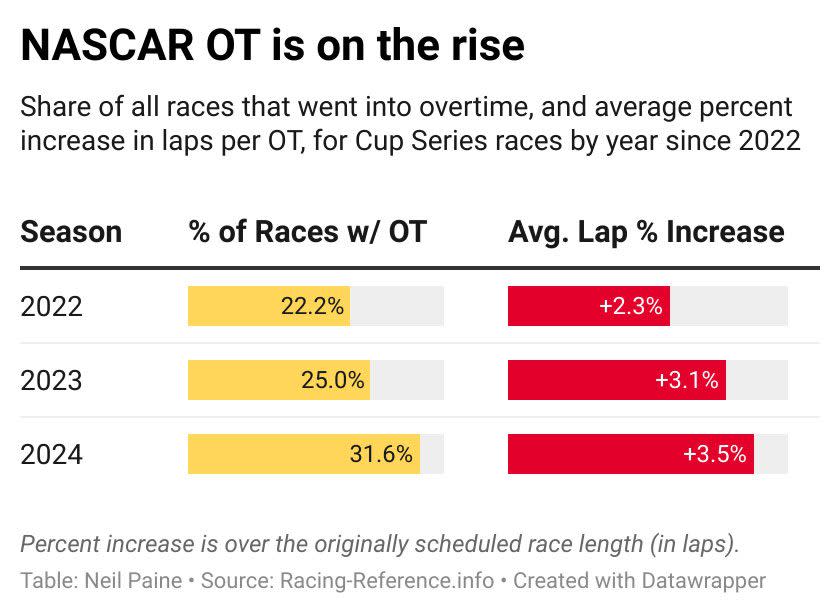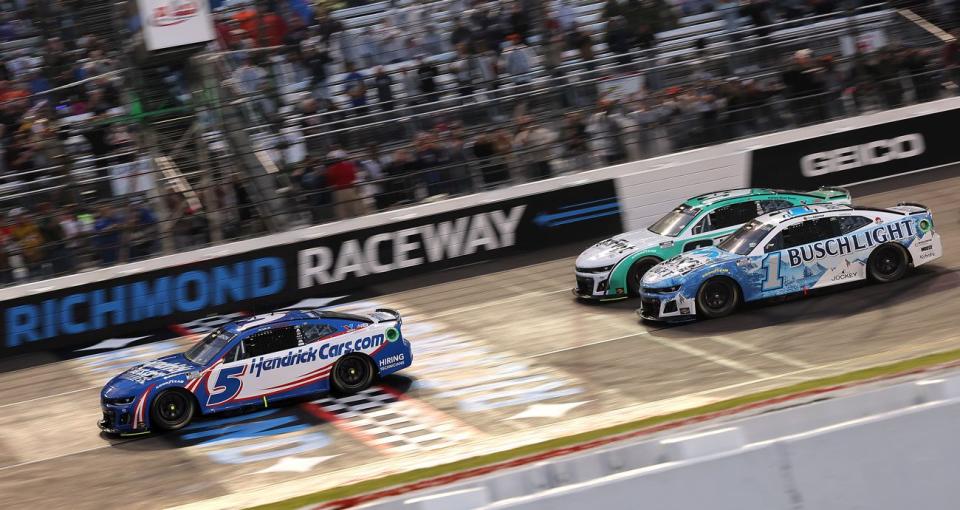Extra innings: How NASCAR's overtime policy would look through other sports' lenses
This past weekend‘s five-overtime finish at Nashville was certainly one way to end a race. After a Cup Series record number of OT restarts — producing 31 extra laps — and with much of the field either wrecked or running out of gas, Joey Logano outlasted the competition to cross the start/finish line first on fumes.
For some, it made for an exciting conclusion to a race with plenty of twists and turns. But there was also plenty of chatter about whether the rule around unlimited green-white-checkered finishes needed tweaking. While it‘s true that Sunday‘s extended OT was historic — not exactly something that happens every week, as Dale Earnhardt Jr. pointed out — it is also true that overtimes are generally on the rise in the Cup Series over the past few seasons:

If overtime affects the outcome of nearly a third of races now, it might be worth looking back at what has been tried before, as well as looking around at what other options might be to provide the best balance between a thrilling finish and what‘s fair (while also making safety a top priority). So in that spirit, let‘s see what kind of cues NASCAR might take from its own history, as well as what a hypothetical — and possibly quite silly! — adaptation of other sports‘ overtime rules to racing might look like.
NASCAR‘s history
NASCAR itself used to simply have races finish under yellow if there was a late-race caution, which is the most straightforward — but perhaps also the most unsatisfying — way to handle the end of a race in the event of a late flag. The old policy also used to provide for racing back to the line on a caution, which is exciting but potentially very dangerous. This led us to the modern green-white-checkered rules in 2004, which initially began with a cap on attempts before moving to unlimited tries in 2017.
The old-school policy is clearly untenable for safety reasons alone, but there is an argument to be had for returning to a limit of three restarts — as the Cup Series‘ rules dictated from 2010-15 — to avoid situations where running out of fuel becomes a widespread problem like it was on Sunday. Of the six races that have gone to OT this season, four only involved one restart, one involved two restarts (the Autotrader EchoPark Automotive 400 at Texas Motor Speedway) and one involved five. So most of the time, a cap on OT restarts wouldn‘t have made much of a difference anyway, but it would provide the crew chiefs with a measure of certainty about exactly how much fuel their cars will need to finish the race.
NFL
The Rule: One 10-minute OT during the regular season, continuous 15-minute OTs in the playoffs. Each team gets at least one possession (unless, in the regular season, the first team on offense scores a touchdown). If the game is still tied after those first possessions, the next score wins.
Possible NASCAR variant: The NFL rules place an emphasis on touchdowns over field goals, and rightly so — putting more distance on the scoreboard between yourself and the opponent is a good thing. So a NASCAR version might involve the race ending early if the leader is able to build a lead of a certain interval (in seconds, perhaps varying by track) by the time they cross a particular scoring loop, regardless of whether they‘ve taken the white flag yet. And like the NFL, NASCAR could also experiment with different rules for playoff races versus the regular season.
College Football
The Rule: Each team gets possession at the opponent‘s 25-yard-line; the leader after those possessions wins. Otherwise, they alternate possessions until a winner is determined, with teams having to attempt a 2-point conversion after TDs starting with the third OT.
Possible NASCAR variant: For better or worse, college football‘s OT policy shrinks the game (and the field) down to its most exciting essence. Racing‘s version of that might be a drag race to the start-finish line over less than a full lap — whether that is a point on the backstretch, or somewhere else — with the winner claiming the spoils no matter what (since nobody would be racing through any carnage created behind them).

MLB
The Rule: A runner is placed on second base at the start of each extra inning, to encourage additional scoring and determine a winner more quickly.
Possible NASCAR variant: The so-called “ghost runner” rule may be among baseball‘s most unpopular tweaks under commissioner Rob Manfred, but it does achieve its desired effect of reducing the number of mega-long (13+ inning) games. Racing‘s version might involve “ghost laps” — having the leader restart OT further down the track than the driver in second place (and second place starting ahead of third, etc.) to give them a better chance of taking the white flag and ending the race.
NBA
The Rule: Continuous 5-minute overtime periods until a winner is determined.
Possible NASCAR variant: Basketball probably has the most normal OT rules of any sport, which makes sense — it‘s also the highest-scoring game, so the odds of one team being ahead of the other after an extra period are pretty high. Because these rules are so basic, they probably most closely mirror NASCAR‘s current system of continuous green-white-checkered restarts, or even the original method of finishing under yellow if necessary.
NHL
The Rule: Continuous 20-minute, sudden-death 5-on-5 OT in the playoffs. Five-minute 3-on-3 sudden death OT in the regular season, followed by a 3-round shootout if tied after OT.
Possible NASCAR variant: Like NASCAR, hockey‘s overtime rules have changed a lot over the years. Originally, the NHL allowed ties, but they moved to the shootout in 2005 and further tweaked the rules to reduce the number of skaters on the ice for OT. Following that trend, NASCAR’s version of this might limit the number of cars on track for an OT restart — say, only involving the Top 10 at the end of regulation and sending the rest of the drivers to the pits. This would ensure that the winner was among the late leaders and reduce the number of rear-of-the-field cars that might bring out a yellow flag, though the battle to be among the Top 10 at the end of regulation could be desperate enough to cause unintended negative consequences.
Soccer (World Cup)
The Rule: Teams play two extra 15-minute periods if tied after 90 minutes of regulation. If they are still tied, the winner is determined through a five-shot penalty shootout.
Possible NASCAR variant: The big complaint about shootouts (whether in soccer or hockey) is that they reduce the main actions of the sport down to a glorified mini-game competition. But if NASCAR were to go the same route, they might have the two leading drivers after regulation engage in dueling qualifying-style laps, with the fastest time earning the victory. Or, to really lean into the gimmickry, they might also have the speed of the team‘s pit crew factor into the result. Embrace the shenanigans!
Should NASCAR enact any of these changes wholesale? Ummm, probably not. But there may yet be some interesting twists worth thinking about by making comparisons with other sports. And whatever happens to the OT rules, one thing is for sure: They will always create conversation, no matter what the powers-that-be decide to do.
Neil Paine is a freelance writer whose work also appears at ESPN.com, The Philadelphia Inquirer, Sherwood News and Substack. He is the former Sports Editor at FiveThirtyEight, and was also a consultant for the NBA‘s Atlanta Hawks.

 Yahoo Sports
Yahoo Sports 
